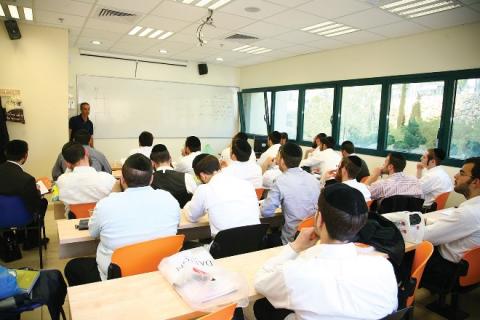A social revolution in Israel: ultra-orthodox men at work
As Malach sees it, young Haredi men are no longer tracked into a life of yeshiva learning but now have two real options in front of them, to study or to work and from there new questions about family and life open up. “It’s here and now and is changing Haredi society in the sense that the labor market inside it has become competitive. It raises questions about income level, about economic status – suddenly there’s a growing middle class. There’s a whole group of people whose livelihood is a lot easier than those going to the yeshivas and kollels,” he said, referring to learning programs for married men.
In fact, the phenomenon of working Haredim is part of a broader movement away from the norms of the Haredi world that developed in the last century. Today, an estimated 11,000 ultra-Orthodox are studying at institutes of higher education; another approximately 5,000 are in the army, and more and more have access to the Internet.
Exactly how many Haredim there are is subject to disagreement in part because there is no formal designation for the community. One definition, based on a labor survey of people ages 25-64 by the National Economic Council, identifies ultra-Orthodox as people living in households where at least one male member's highest level of completed education was a yeshiva or kollel. That survey shows the Haredi male labor force participation rate passed 50% last year.
The Central Bureau of Statistics has finetuned this model in its survey by examining where the respondent lives and ignores Haredim who have served in the army or attended an institute of higher education, two other taboos in the ultra-Orthodox world. The CBS’s survey put the ultra-Orthodox participation rate at 49.8% last year, just under a majority but likely to surpass the 50% mark this year. A second method for measuring the participation rate is based on self-reporting, which the CBS said showed more than half of Haredi men were in the labor force last year. (A 2013 survey showed the rate was 56%, but that was based on a much smaller sampling).
Bnei Brak resident Moishe Friedman, 39, is a case study. Five years ago he was a full-time avrech (adult student) living on stipends when he left to join the world of high-tech. Today he is CEO of Kamatech, which helps Haredim enter the industry. “I studied at the Hebron Yeshiva in Jerusalem. My friends were the top students," he recalled. "When we got to age 27-28, those who wanted to work or study at university did it secretly. It was embarrassing, something you hid. We studied [at university] but didn’t tell our families. What’s happened in the last few years is that the embarrassment has disappeared."
Not everyone is convinced a social revolution is under way. “It’s ridiculous, in my opinion nothing has happened. The society of learners has grown, not shrunk,” said Moshe Gafni, the Haredi chairman of the Knesset Finance Committee and a lawmaker for the United Torah Judaism party. “The only change you can point to relative to the past is that Haredim are working. A lot want to earn normal salaries and live better than they lived 30 years ago.”
Yair Ettinger

